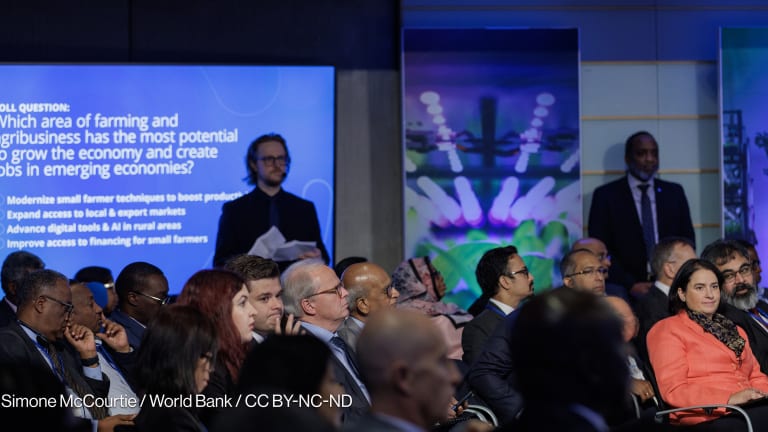
DAVOS, Switzerland — Finding ways to channel more private investment into humanitarian settings was a hot topic this year at Davos — the World Economic Forum’s 48th annual meeting in Switzerland — which included the tentative launch of a development impact bond to create jobs for Syrian refugees.
The IKEA Foundation said it will provide €6.8 million ($7.7 million) to fund the outcomes of the bond, which has been put together by impact finance firm KOIS, and aims to help up to 12,000 Syrian refugees and host populations in Jordan and Lebanon earn a living. The development impact bond still needs to attract $20 million from other outcome funders, however, if it is to get off the ground.
“We need to … identify more examples of investable propositions which have worked so that they can be replicated, but we shouldn’t confuse things by imagining that businesses want to give a lot of money away to solve humanitarian crises.”
— Mark Lowcock, under-secretary-general for humanitarian affairs, UNOCHANew research by British think tank the Overseas Development Institute shows that job creation activities have the potential to offer a financial and social return on investment. But some delegates expressed reservations about the role the private sector should play in financing humanitarian efforts.
Mark Lowcock, head of the U.N. Office for the Coordination of Humanitarian Affairs, said that while he sees a big opportunity for the private sector to come in where there are “investable activities,” it is important not to assume too much from investors and businesses that are ultimately profit-driven.
“What we need to do is identify more examples of investable propositions which have worked so that they can be replicated, but we shouldn’t confuse things by imagining that businesses want to give a lot of money away to solve humanitarian crises … At the end of the day they are businesses and most of the core humanitarian activity will need to continue to be financed by grants,” he told Devex on the sidelines of the meetings.
In search of financing
The development impact bond is part of a broader effort to attract new financing for humanitarian efforts in the face of an increasing number of protracted crises. Between 2005-2017, the number of active crises nearly doubled from 16 to 30 and the average length of active United Nations interagency appeals also increased, according to UNOCHA.
Despite these growing needs, donor financing has not kept pace. Experts also say funding needs to be longer-term and to embrace the humanitarian-development continuum in order to reflect the extended nature of the crises.
Speaking to Devex in Davos, Per Heggenes, CEO at the IKEA Foundation, said that financial tools such as development impact bonds could help bridge the funding gap.
“The needs are increasing, and we can’t expect it all to be covered by donors; we have to look to involve the private sector partly on the funding side but also [for] their knowledge and networks which can be more valuable than just money,” Heggenes said.
Explaining why the foundation was keen to support the impact bond, he added: “With the DIB structure … we get the risk capital upfront and create a model with specific targets which carefully measures impact … and incentivizes all players to do better and stretch [themselves].”
“The needs are increasing, and we can’t expect it all to be covered by donors.”
— Per Heggenes, CEO, IKEA FoundationHe also said that by testing and, hopefully, proving the model, they could attract other investors to similar products.
Béatrice Delperdange, head of business development at KOIS, said the DIB would include a “thorough evaluation framework” which would collect and publish data on jobs created, spending on basic needs, and the effect on women’s self-reported agency and confidence.
“Our aim is also to help bridge the nexus between development and humanitarian finance. We seek to bring new sources of finance to this space, catalyzing large and sustainable change in the funding of development initiatives in humanitarian contexts,” she said.
Rethinking the possibilities
The forum also saw the official launch of a high-level group on humanitarian investing, headed by WEF, the World Bank, and the International Committee of the Red Cross, which will bring together investors, business leaders, and representatives from the humanitarian and development sectors to “deliver impact through concrete investable projects,” according to the press release.
Sara Pantuliano, ODI’s acting executive director and a member of the high-level group, which met Wednesday, told Devex it was promising to see financing for humanitarian and fragile settings feature heavily on the agenda — more so than in previous years.
More from Davos:
► How collaborative philanthropy efforts are starting to learn from one another
► Y analytics aims to bridge gap between research and impact measurement
► As Davos gathers, the development community struggles for attention
The next step is to develop and test “more examples of investable opportunities and analyze what’s been done so far and what has worked and why … so that we can help build an investment theme,” Pantuliano said. She added that humanitarian investing could ultimately be as big as renewables, which 10 years ago nobody saw as a credible asset class.
Speaking during a session Tuesday, Peter Maurer, president at ICRC, said aid actors tend to have a “completely wrong impression” about fragile states, seeing them as “places where it is impossible to do something.” While many organizations are working on income-generating activities, they tend to be “left alone by the international aid system,” he said.
Maurer called on humanitarian, development, private, and public actors to develop a “much more sophisticated financial structure, cooperative structure, complementary structure between the different actors ... in order to generate more impact for people in a more meaningful way than we are ... able to do so at the present moment.”
Others agreed there is work to do. Ion Yadigaroglu, managing partner at Capricorn Investment Group, which has a few small investments in low-income countries and has done some co-investing with development finance institutions, said the experience has been “challenging” and “mixed.”
Investors such as Capricorn still find it hard to go into high-risk countries, he said, because groups such as the World Bank have not yet offered the “kind of effective risk mitigation, standardization type efforts, and information sharing efforts” they need to “reduce those frictions and be more comfortable in going to a place like South Sudan.”








